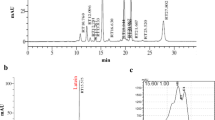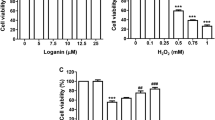Abstract
DMEM/F12 nutrient mixture, a recommended media for ARPE-19 culture, contains glucose concentration of 17.5 mM. But, several recent studies employed normal glucose media (5.5 mM) that was shown to affect the growth and function of ARPE-19 cells. Here, we set a protocol to study the effect of hyperglycemia on intracellular oxidative stress and redox status in ARPE-19 using DMEM/F12 as control. The WST-1 assay was performed to analyze the viability of ARPE-19 upon glucose treatment. The intracellular oxidative stress was measured by a dichlorofluorescein assay. The mitochondrial membrane potential (MMP) was monitored by using a JC-10 MMP assay kit. The expression of antioxidant marker proteins was analyzed by western blotting. Exogenous addition of glucose (7.5 and 12.5 mM) for 24 and 48 h did not change the viability and morphology of ARPE-19 cells. Hyperglycemia increased intracellular ROS level and decreased MMP in a dose-dependent manner. High-glucose treatment for 24 h down-regulated the protein expression of redox-specific transcription factors Nrf-2, XBP-1 and NF-κB, and subsequently decreased the expression of HO-1, catalase, and SOD-2. This study offers baseline information for the subsequent use of DMEM/F12 nutrient mixture to study glucose-mediated changes in intracellular oxidative stress and redox status of ARPE-19 without affecting its basic functions.






Similar content being viewed by others
Abbreviations
- ARE:
-
Antioxidant response element
- ARPE-19:
-
Adult retinal pigment epithelial cell line-19
- ATCC:
-
American type culture collection
- CCCP:
-
Carbonyl cyanide m-chlorophenyl hydrazine
- CRALBP:
-
Cellular retinaldehyde-binding protein
- DCF:
-
Dichlorofluorescein
- DCFH-DA:
-
2′,7′-Dichlorofluorescein diacetate
- DMEM/F12:
-
Dulbecco’s modified eagle medium nutrient mixture F-12
- ER:
-
Endoplasmic reticulum
- FBS:
-
Fetal bovine serum
- HEPES:
-
4-(2-Hydroxyethyl)-1-piperazineethanesulfonic acid
- HO-1:
-
Heme oxygenase 1
- H2O2 :
-
Hydrogen peroxide
- MMP:
-
Mitochondrial membrane potential
- NFκB:
-
Nuclear factor kappa B
- Nrf2:
-
Nuclear factor erythroid-2 related factor 2
- POS:
-
Photoreceptor outer segment
- ROS:
-
Reactive oxygen species
- RPE:
-
Retinal pigmental epithelium
- RPE-65:
-
Retinal pigment epithelium-specific 65 kDa protein
- SOD-2/MnSOD:
-
Superoxide dismutase 2/manganese-dependent superoxide dismutase
- WST-1:
-
Water-soluble tetrazolium salt-1
- XBP-1:
-
X-box binding protein
- ZO-1:
-
Zonula occludens-1
References
Hamann S (2002) Molecular mechanisms of water transport in the eye. Int Rev Cytol 215:395–431
Simo R, Villarroel M, Corraliza L, Hernandez C, Garcia-Ramirez M (2010) The retinal pigment epithelium: Something more than a constituent of the blood-retinal barrier-implications for the pathogenesis of diabetic retinopathy. J Biomed Biotechnol 2010:190724
Davidson AE, Millar ID, Urquhart JE, Burgess-Mullan R, Shweikh Y, Parry N, O’Sullivan J, Maher GJ, McKibbin M, Downes SM, Lotery AJ (2009) Missense mutations in a retinal pigment epithelium protein, bestrophin-1, cause retinitis pigmentosa. Am J Hum Genet 85:581–592
Bianchi E, Scarinci F, Ripandelli G, Feher J, Pacella E, Magliulo G, Gabrieli CB, Plateroti R, Plateroti P, Mignini F, Artico M (2013) Retinal pigment epithelium, age-related macular degeneration and neurotrophic keratouveitis. Int J Mol Med 31:232–242
Dunn KC, Aotaki-keen AE, Putkey FR, Hjelmeland LM (1996) ARPE-19, a human retinal pigment epithelial cell line with differentiated properties. Exp Eye Res 62:155–170
Kannan R, Zhang N, Sreekumar PG, Spee CK, Rodriguez A, Barron E, Hinton DR (2006) Stimulation of apical and basolateral VEGF-A and VEGF-C secretion by oxidative stress in polarized retinal pigment epithelial cells. Mol Vis 12:1649–1659
Maminishkis A, Chen S, Jalickee S, Banzon T, Shi G, Wang FE, Ehalt T, Hammer JA, Miller SS (2006) Confluent monolayers of cultured human fetal retinal pigment epithelium exhibit morphology and physiology of native tissue. Invest Ophthalmol Vis Sci 47:3612–3624
Mao Y, Finnemann SC (2012) Analysis of photoreceptor outer segment phagocytosis by RPE cells in culture. Humana Press, Totowa, pp 285–295
Azad MB, Chen Y, Gibson SB (2009) Regulation of autophagy by reactive oxygen species (ROS): implications for cancer progression and treatment. Antioxid Redox Signal 11:777–790
Fragoso MA, Patel AK, Nakamura REI, Yi H, Surapaneni K, Hackam AS (2012) The Wnt/β-catenin pathway cross-talks with STAT3 signaling to regulate survival of retinal pigment epithelium cells. PLoS ONE 7:e46892
Zhong Y, Li J, Wang JJ, Chen C, Tran JTA, Saadi A, Yu Q, Le YZ, Mandal MNA, Anderson RE, Zhang SX (2012) X-Box binding protein 1 is essential for the anti-oxidant defense and cell survival in the retinal pigment epithelium. PLoS ONE 7:e38616
Sheu SJ, Liu NC, Ou CC, Bee YS, Chen SC, Lin HC, Chan JY (2013) Resveratrol stimulates mitochondrial bioenergetics to protect retinal pigment epithelial cells from oxidative damage. Invest Ophthalmol Vis Sci 54:6426–6438
Kowluru RA, Mishra M (2015) Oxidative stress, mitochondrial damage and diabetic retinopathy. Biochim Biophys Acta 1852:2474–2483
Kensler TW, Wakabayashi N, Biswal S (2007) Cell survival responses to environmental stresses via the Keap1-Nrf2-ARE pathway. Annu Rev Pharmacol Toxicol 47:89–116
Lewis KN, Mele J, Hayes JD, Buffenstein R (2010) Nrf2, a guardian of healthspan and gatekeeper of species longevity. Integr Comp Biol 50:829–843
Bai Y, Cui W, Xin Y, Miao X, Barati MT, Zhang C, Chen Q, Tan Y, Cui T, Zheng Y, Cai L (2013) Prevention by sulforaphane of diabetic cardiomyopathy is associated with up-regulation of Nrf2 expression and transcription activation. J Mol Cell Cardiol 57:82–95
Siewert S, González I, Santillán L, Lucero R, Ojeda MS, Gimenez MS (2013) Downregulation of Nrf2 and HO-1 expression contributes to oxidative stress in type 2 diabetes mellitus: a study in Juana Koslay City, San Luis, Argentina. J Diabetes Mellit 3:71–78
Luo Y, Zhuo Y, Fukuhara M, Rizzolo LJ (2006) Effects of culture conditions on heterogeneity and the apical junctional complex of the ARPE-19 cell line. Invest Ophthalmol Vis Sci 47:3644–3655
Heimsath EG, Unda R, Vidro E, Muniz A, Villazana-Espinoza ET, Tsin A (2006) ARPE-19 cell growth and cell functions in euglycemic culture media. Curr Eye Res 31:1073–1080
Nicholls DG (2004) Mitochondrial membrane potential and aging. Aging Cell 3:35–40
Obuobi S, Karatayev S, Chai CLL, Ee PLR, Ma´tyus P (2016) The role of modulation of antioxidant enzyme systems in the treatment of neurodegenerative diseases. J Enzyme Inhib Med Chem 31:194–204
Jiménez-Osorio AS, Picazo A, González-Reyes S, Barrera-Oviedo D, Rodríguez-Arellano ME, Pedraza-Chaverri J (2014) Nrf2 and redox status in prediabetic and diabetic patients. Int J Mol Sci 15:20290–20305
Zhou LZH, Johnson AP, Rando TA (2001) NFκB and AP-1 mediate transcriptional responses to oxidative stress in skeletal muscle cells. Free Radic Biol Med 31:1405–1416
Liu Y, Adachi M, Zhao S, Hareyama M, Koong AC, Luo D, Rando PA, Imai K, Shinomura Y (2009) Preventing oxidative stress: a new role for XBP1. Cell Death Differ 16:847–857
Gutiérrez-Uzquiza Á, Arechederra M, Bragado P, Aguirre-Ghiso JA, Porras A (2012) p38α mediates cell survival in response to oxidative stress via induction of antioxidant genes: effect on the p70S6K pathway. J Biol Chem 287:2632–2642
Beatty S, Koh H-H, Phil M, Henson D, Boulton M (2000) The role of oxidative stress in the pathogenesis of age-related macular degeneration. Surv Ophthalmol 45:115–134
Shen J, Yang X, Dong A, Petters RM, Peng YW, Wong F, Campochiaro PA (2005) Oxidative damage is a potential cause of cone cell death in retinitis pigmentosa. J Cell Physiol 203:457–464
Kowluru RA, Chan P-S (2007) Oxidative stress and diabetic retinopathy. Exp Diabetes Res 2007:1–12
Ye ZW, Zhang J, Townsend DM, Tew KD (2015) Oxidative stress, redox regulation and diseases of cellular differentiation. Biochim Biophys Acta 1850:1607–1621
Samuels IS, Cutler AH, Tarchick MJ, Anand-Apte B (2016) The contribution of RPE-specific insulin signaling to the development of outer retina dysfunction associated with diabetes. Invest Ophthalmol Vis Sci 57:5422
Ahmado A, Carr AJ, Vugler AA, Semo M, Gias C, Lawrence JM, Chen LL, Chen FK, Turowski P, da Cruz L, Coffey PJ (2011) Induction of differentiation by pyruvate and DMEM in the human retinal pigment epithelium cell line ARPE-19. Invest Ophthalmol Vis Sci 52:7148–7159
Fronk AH, Vargis E (2016) Methods for culturing retinal pigment epithelial cells: a review of current protocols and future recommendations. J Tissue Eng 7:1–23
Samuel W, Jaworski C, Postnikova OA, Kutty RK, Duncan T, Tan LX, Poliakov E, Lakkaraju A, Redmond TM (2017) Appropriately differentiated ARPE-19 cells regain phenotype and gene expression profiles similar to those of native RPE cells. Mol Vis 23:60–89
Xie P, Fujii I, Zhao J, Shinohara M, Matsukura M (2012) A novel polysaccharide compound derived from algae extracts protects retinal pigment epithelial cells from high glucose-induced oxidative damage in vitro. Biol Pharm Bull 35:1447–1453
Arnal E, Johnsen-Soriano S, Lopez-Malo D, Perez-Pastor G, Vidal-Gil L, Morillas N, Sancho-Pelluz J, Romero FJ, Barcia JM (2016) Docosahexaenoic acid protects against high glucose-induced oxidative stress in human retinal pigment epithelial cells. ROS 2:298–307
Fu D, Tian X (2017) Effect of astaxanthin on retinal pigment epithelial cells in high glucose: an in-vitro study. Biomed Res 28:6839–6843
Yang H, Jin X, Kei Lam CW, Yan S-K (2011) Oxidative stress and diabetes mellitus. Clin Chem Lab Med 49:1773–1782
Wu Y, Tang L, Chen B (2014) Oxidative stress: implications for the development of diabetic retinopathy and antioxidant therapeutic perspectives. Oxid Med Cell Longev 2014:1–12
Chen JY, Chou HC, Chen YH, Chan HL (2013) High glucose-induced proteome alterations in hepatocytes and its possible relevance to diabetic liver disease. J Nutr Biochem 24:1889–1910
Zhang W, Song J, Zhang Y, Ma Y, Yang J, He G, Chen S (2018) Intermittent high glucose-induced oxidative stress modulates retinal pigmented epithelial cell autophagy and promotes cell survival via increased HMGB. BMC Opthalmol 18:192
Fardoonian M, Halbach C, Slinger C, Pattnaik BR, Sorenson CM, Sheibani N (2016) High glucose promotes the migration of retinal pigment epithelial cells through increased oxidative stress and PEDF expression. Am J Physiol Cell Physiol 311:C418–C436
Schieber M, Chandel NS (2014) ROS function in redox signaling and oxidative stress. Current Biol 24:R453–R462
Ishii T, Itoh K, Takahashi S, Sato H, Yanagawa T, Katoh Y, Bannai S, Yamamoto M (2000) Transcription factor Nrf2 coordinately regulates a group of oxidative stress-inducible genes in macrophages. J Biol Chem 275:16023–16029
Kowluru RA, Kowluru V, Xiong Y, Ho YS (2006) Overexpression of mitochondrial superoxide dismutase in mice protects the retina from diabetes-induced oxidative stress. Free Radic Biol Med 41:1191–2006
Góth L (2008) Catalase deficiency and type 2 diabetes. Diabetes Care 31:e93
Farnoodian M, Halbach C, Slinger C, Pattnaik BR, Sorenson CM, Sheibani N (2016) High glucose promotes the migration of retinal pigment epithelial cells through increased oxidative stress and PEDF expression. Am J Physiol Cell Physiol 311:418–436
Wang J, Fields J, Zhao C, Langer J, Thimmulappa RK, Kensler TW, Yamamoto M, Biswal S, Dore S (2007) Role of Nrf2 in protection against intracerebral hemorrhage injury in mice. Free Radic Biol Med 43:408–414
Stefanson AL, Bakovic M (2014) Dietary regulation of Keap1/Nrf2/ARE pathway: focus on plant-derived compounds and trace minerals. Nutrients 6:3777–3801
Wang SH, Lee WC, Chou HC (2015) Retinal proteins associated with redox regulation and protein folding play central roles in response to high glucose conditions. Electrophoresis 36:902–909
Yao J, Tao ZF, Li CP, Li XM, Cao GF, Jiang Q, Yan B (2014) Regulation of autophagy by high glucose in human retinal pigment epithelium. Cell Physiol Biochem 33:107–116
Acknowledgements
The author, Arpitha H S acknowledges the University Grants Commission (UGC), New Delhi, India for granting Research Fellowship. The authors thank the Academy of Scientific & Innovative Research (AcSIR) and the Director, CSIR-CFTRI for the constant support to carry out this work.
Funding
This study was funded by the 12th Five Year Plan Project (BSC-0404) of CSIR, New Delhi.
Author information
Authors and Affiliations
Corresponding author
Ethics declarations
Conflict of interest
The authors declare no conflict of interest.
Additional information
Publisher’s Note
Springer Nature remains neutral with regard to jurisdictional claims in published maps and institutional affiliations.
Rights and permissions
About this article
Cite this article
Haranahalli Shivarudrappa, A., Gopal, S.S. & Ponesakki, G. An in vitro protocol to study the effect of hyperglycemia on intracellular redox signaling in human retinal pigment epithelial (ARPE-19) cells. Mol Biol Rep 46, 1263–1274 (2019). https://doi.org/10.1007/s11033-019-04597-x
Received:
Accepted:
Published:
Issue Date:
DOI: https://doi.org/10.1007/s11033-019-04597-x




